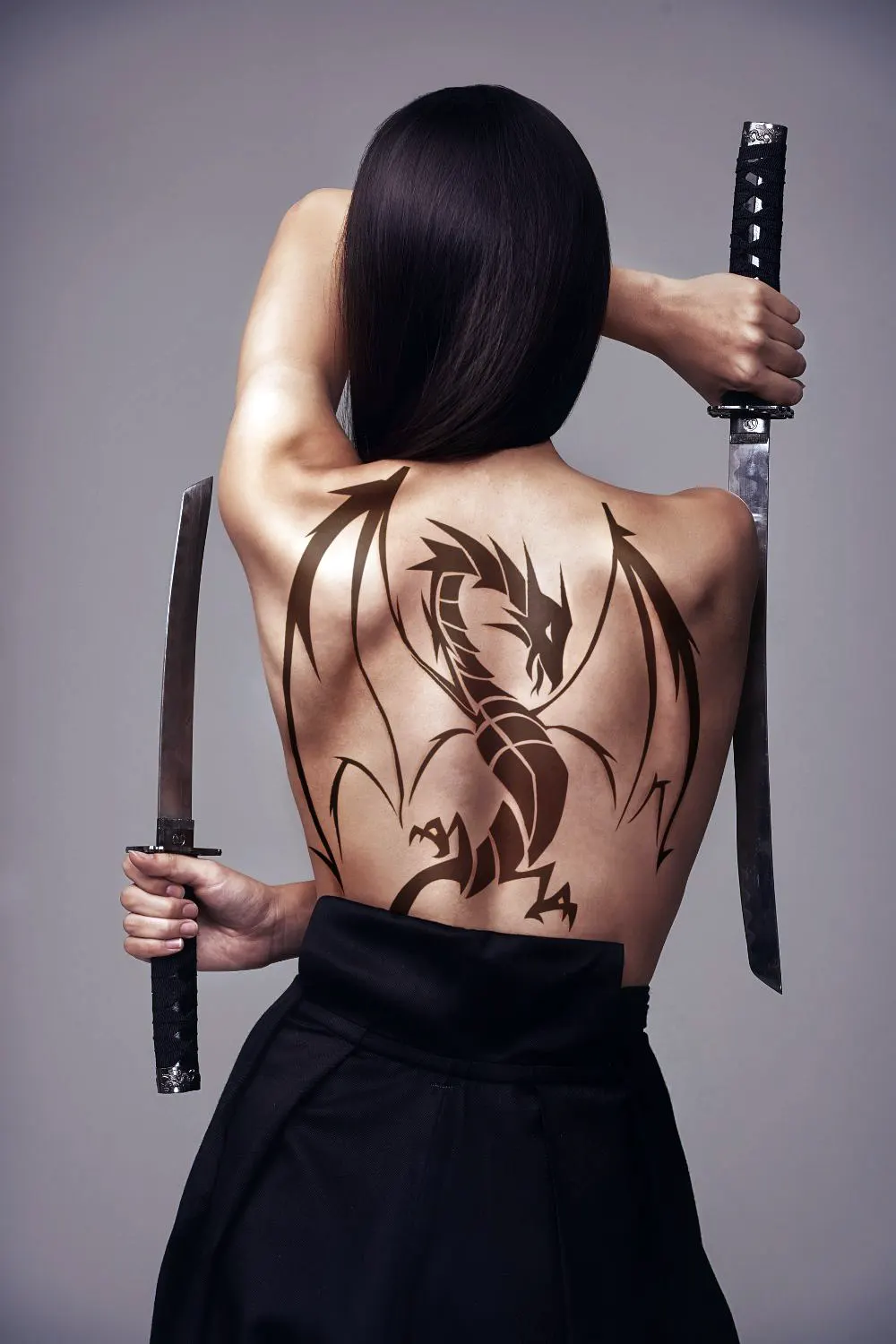While popular culture portrays kunoichis wearing revealing clothing as part of their tactics, evidence of real female ninjas in ancient Japan is limited. Some sources claim the idea of seductive ninja assassins is a myth. They say kunoichis are trained in the same strategic and tactical skills as male ninjas, including espionage, intelligence gathering, disguise, and guerilla warfare.
Though depictions of female ninjas in media tend to be sexualized, no clear evidence shows revealing outfits as part of their practice. It’s worth exploring why female ninjas may have worn revealing clothing and whether popular culture reflects historical facts.
Why do female ninjas wear revealing outfits?
The idea that ninjas wore all-black costumes with masks, which revealed only the eyes, is a myth. Historical facts suggest that the ninja strove to look ordinary and dress appropriately for each mission not to arouse suspicion. Here are a few reasons why female ninjas are often depicted wearing revealing outfits.
Seduction tactic for gaining trust
Kunoichi, the female ninjas, were skilled warriors who were trained in combat and stealth, just like male ninjas. They utilized a variety of tactics according to their mission needs.
Popular culture tends to portray kunoichi as seductresses who wore revealing clothes to seduce targets.
However, historians believe they instead relied on their combat skills, intellect, and charm to accomplish missions rather than using their appearance.
While kunoichi may have used some feminine tactics as part of disguises, there is no evidence that revealing outfits were a common practice among female ninjas based on historical records. In reality, the outfits and tactics of kunoichi likely varied based on their individual missions.

Enhanced mobility for quick movements
Revealing outfits can give greater mobility to female ninjas by allowing them to move quickly and quietly without clothing restricting their movements. Loose-fitting clothing enables better free movement.
Some peoples say that female ninjas often wore loose clothing to remain undetected. Revealing clothing might make them conspicuous and easier targets.
Female ninjas likely chose revealing or loose outfits based on their mission needs. If seducing targets, revealing clothing might help female ninjas. But if moving through crowds unnoticed, they likely wore loose clothing.
Historical records do not clearly show what outfits female ninjas commonly used. Popular depictions of female ninjas in revealing clothing tend to be titillating rather than historically accurate.
Clothing as a distracting element
Revealing outfits can serve as distractions for female ninjas. Revealing clothing can divert targets’ attention from a female ninja’s true intentions. This enables female ninjas to gain a target’s trust or move without notice.
The famous female ninja Mochizuki Chiyome used her beauty in this way to assassinate warlords. Revealing clothing allows a female ninja to blend into a crowd so she can move around undetected.
However, revealing outfits can also draw unwanted attention, making a female ninja a target. Though revealing outfits as distractions work for female ninjas, men, and women have used this tactic effectively throughout history.
Ultimately, whether a revealing outfit helps or hinders depends on the situation and a female ninja’s ability to use it wisely without attracting unwanted attention that compromises her mission.
Popular culture depiction
Popular culture frequently portrays female ninjas in revealing outfits. This is likely done for aesthetic purposes and fan service. Revealing outfits highlight a female ninja’s beauty, which can be seen as desirable in action movies and games.
Female ninjas in revealing clothing also provide fan service by appealing to audiences’ interest in attractive characters, a common trope in anime and manga.
While not all depictions of female ninjas are sexualized, the revealing outfit trope remains prevalent. Examples include Tsunade from Naruto in bikinis and miniskirts, Elektra from Marvel Comics in leather catsuits, and Karai from Teenage Mutant Ninja Turtles in crop tops and leather pants.
Though common, revealing outfits for female ninjas in popular culture do not reflect historical accuracy.
Reflects objectification of women
The portrayal of female ninjas in revealing outfits may reflect society’s objectification of women, where women’s bodies are primarily valued for sex appeal rather than skills. This sends the message female ninjas’ abilities as warriors are not important.
When only valued for looks, it hinders women from being seen as equals. We need to challenge this portrayal. We must show that women’s bodies are valuable for strength, intellect, and achievements beyond sexual appeal.
We can support media with positive female ninja portrayals. We can write to creators expressing disappointment with objectifying female ninjas. We must start discussions to change the way society sees women.

Real-world impact
The portrayal of female ninjas in revealing outfits can impact how women are perceived and treated in real life. Research finds women exposed to scantily clad images are more likely to experience sexual harassment.
Depictions of revealing outfit ninjas reinforce the idea that women are only valued for their looks. This objectification makes it hard for women to be taken seriously.
In extreme cases, revealing outfits are used to justify sexual violence through beliefs that women who dress revealingly “ask for it”. We must challenge these portrayals and demand positive representations of women that show women’s bodies as valuable beyond sexual appeal for their strength, intellect, and abilities.
We can support media with positive female ninjas. We can express disappointment to creators with objectifying portrayals and start discussions about changing perceptions of women.
Why are kunoichi sexualized?
Reports claim kunoichi were sexualized within their own ninja clans and trained in seduction. However, no historical records prove this.
Some sources say kunoichi were to awaken sensual attraction in targets and act as courtesans. But how common and revealing their tactics remain unclear.
The primary reason for revealing outfits in popular culture likely stems from the objectification of women in society, where female bodies are valued for sexual appeal over skills. Sexualizing kunoichi perpetuates harmful beliefs that diminish women’s worth beyond physical attractiveness.
Some argue revealing outfits empower kunoichi by allowing them to use their sexuality as a weapon to challenge gender roles. However, this argument remains controversial as it can reinforce the notion women’s value lies in being sexually appealing.
Overall, sexualizing kunoichi in popular culture likely arises from a mix of reasons, including alleged clan practices, supposed seduction tactics, objectification of women, and debates on empowerment through sexuality.
But portrayals as sexualized ninja assassins lack historical accuracy and risk reinforcing negative stereotypes that women’s value depends on being attractive. Rather than empowering, over-sexualization risks further marginalizing kunoichi by ignoring their actual skills and capabilities as lethal warriors.
Presenting kunoichi in revealing outfits excessively reduces them to sex objects that cater to male desires. We must move beyond these tropes to reveal the nuanced humanity of female ninjas as complex individuals whose worth transcends physical appearance.
Prioritizing skills over sexuality will truly honor kunoichi for their mastery of the deadly arts of the ninja.
What is the difference between a ninja and a kunoichi?
While ninja commonly refers to any practitioner of ninjutsu – an array of skills used for espionage, sabotage, and guerrilla warfare- kunoichi specifically means a female ninja.
Ninjas, usually males, were hired as spies, killers, and infiltrators during Japan’s feudal period. They underwent training in combat, stealth, and information gathering. They were known for their agility, stealth, and camouflage skills. Historical records show both male and female ninjas existed.
Kunoichi, meaning “female” in Japanese, refers to female ninjas. The term gained popularity in novels, TV, movies, and manga more than from historical records, which lack evidence of female ninjas performing the same reconnaissance and subversive roles as males.
Popular culture portrays kunoichi as masters of seduction and assassination using their beauty. However, female ninjas likely received similar training as male ninjas in combat skills and stealth. While female ninjas undoubtedly existed, the portrayal of kunoichi in popular media may not accurately reflect their true history and roles.
In summary, the key difference lies in the specific meaning of the terms. Ninja refers broadly to anyone who practices ninjutsu, while kunoichi refers specifically and narrowly to female ninjas. Further, little is conclusively known about historical female ninjas and their roles compared to males.
Popular depictions of kunoichi as seductive warriors lack much historical backing and risk oversexualizing rather than honoring female ninjas for the actual combat skills and strategic mindsets they likely possessed.
A more accurate and nuanced portrayal of kunoichi’s grit, intelligence, and guile beyond their appearance would help recognize female ninjas as lethal warriors in their own right.
Difference between Ninja and Kunoichi
| Criteria | Ninja | Kunoichi |
|---|---|---|
| Definition | Practitioner of ninjutsu | Female ninja or practitioner of ninjutsu |
| Historical Role | Espionage, sabotage, guerrilla | Espionage, sabotage, guerrilla (limited evidence) |
| Gender | Typically male | Female |
| Skills | Combat, disguise, stealth, info. | Similar to male ninjas |
| Popularity | Known historically | Gained popularity through creative works |

Summary
The portrayal of kunoichi wearing revealing clothing in popular culture is not historically accurate. Though they were trained in combat and stealth like male ninjas, there is limited evidence that female ninjas wore revealing clothing as part of their practice.
Depictions of female ninjas in media tend to be sexualized, which may reflect society’s objectification of women. Prioritizing skills over sexuality will truly honor kunoichi for their mastery of the deadly arts of the ninja.
The key difference between ninja and kunoichi is that ninja refers broadly to anyone who practices ninjutsu, while kunoichi refers specifically and narrowly to female ninjas.
FAQ
Who is the greatest female ninja in history?
There were many skilled and accomplished female ninjas and kunoichi throughout history; the greatest female ninja is a matter of opinion. Some notable examples include Mochizuki Chiyome, Tsukikage Ran, Tomoe Gozen, Makie Otono-Tachibana, and Tsunade.
Who is the prettiest kunoichi in Naruto?
In Naruto, there are many beautiful kunoichis, making it subjective to determine the prettiest. However, popular contenders include Sakura Haruno, known for her beauty and determination, Hinata Hyuga, admired for her gentle beauty and kind heart, Tsunade, recognized for her beauty, strength, and medical skills, Mei Terumi, esteemed for her beauty, intelligence, and water-based jutsu, and Konan, celebrated for her beauty, origami skills, and paper-based jutsu.
Who was the first female American Ninja Warrior?
Kacy Catanzaro was the first female American Ninja Warrior. In 2014, she became the first woman ever to complete a city finals course and the second woman ever to qualify for the finals. Catanzaro, a former Towson University gymnast, made history with her impressive run on the show.
Who is the strongest female kunoichi in Naruto?
Tsunade is considered one of the strongest female kunoichi in Naruto. She is a legendary Sannin and the Fifth Hokage of the Hidden Leaf Village. She is known for her immense strength, medical ninjutsu, and chakra control.
Were ninjas allowed to marry?
Yes, ninjas were allowed to marry as they needed to produce offspring. However, the oniwaban, who were ninjas in government employ, were not allowed to marry to avoid any conflicts of interest and maintain the secrecy of their missions.



